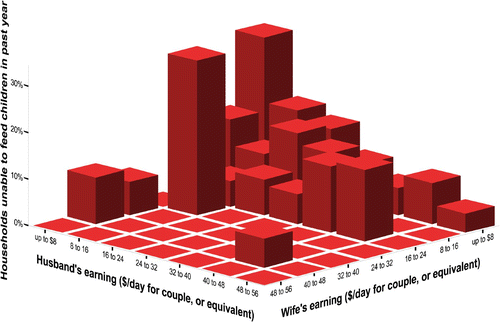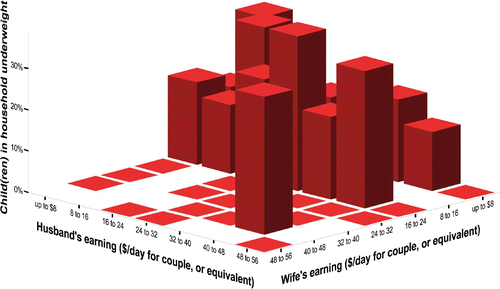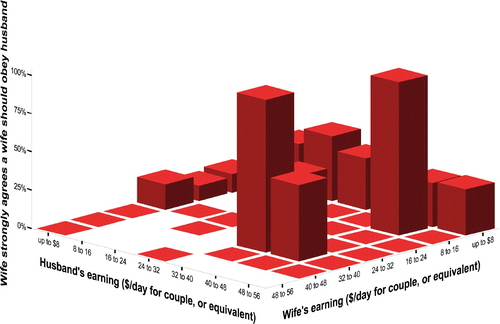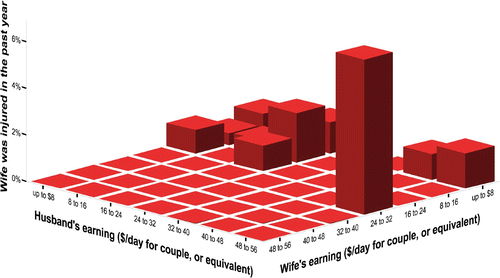Abstract
The ‘children fare better’ viewpoint claims that children tend to be better fed if their mother (as opposed to father) has sufficient income of her own for food. This paper assesses this claim for South Africa, using data from household surveys. It considers the possibility that this issue is related to domestic violence between husband and wife, and finds an apparent link between wife's earnings, child nutrition and domestic violence. Children's well-being seems more assured if mothers have an adequate income; but there is more risk of inadequate nutrition in households where there is domestic violence against wives.
1. INTRODUCTION
In many less-developed countries, a large fraction of households are poor. Aliber (Citation2003:475) suggests that child undernutrition is a reasonable proxy for income poverty, citing an estimate that about 23 per cent of South African children aged below six are ‘stunted’ (i.e. below the appropriate height for their age). Low income is not the only reason for hunger: some researchers claim that many children suffer undernutrition because parents (with adequate incomes) choose to buy non-food items. Haddad and Reardon Citation(1993), for example, claim that many children suffer undernutrition because their parents buy non-essential items such as alcohol. There is evidence from various developing countries that children tend to eat better if mothers earn money or control household spending, or both, and that children in some relatively rich households go hungry because their mothers lack control over spending. This paper examines how women's earnings affect child welfare, using empirical evidence from household surveys in South Africa. It finds a complex connection between parents’ earnings and children's welfare.
‘Children fare better’, a popular recent hypothesis in development studies, claims that children tend to do better if mothers earn, and is associated with economic bargaining models (Hoddinott & Haddad, Citation1995:77). Folbre (Citation1986:24) states that ‘A number of studies suggest that increases in women's income have a far more positive impact on increases in children's nutritional levels than do increases in men's incomes’. In a study on Ghana, Jette Bukh (Citation1980:19) observes that ‘Men and women also use their cash differently. While men, and particularly younger men, often use their cash to buy goods for themselves – “bachelors’ consumption goods” – the women's little money is usually used to cover certain household expenses’. In Brazil, the effects of a wife's earnings are almost 20 times stronger than the effects of a husband's earnings in improving child nutrition (Thomas cited in Lundberg & Pollak, Citation1996:144). The ‘children fare better’ hypothesis claims that women who earn more tend to have more power, and that their power over spending tends to help children, whether their power derives from their earnings or other causes. There is evidence from Rwanda, the Gambia, Côte d'Ivoire, Guatemala, Jordan and Mali that children fare better when mothers have more control over household decisions (Kennedy & Peters, Citation1992:1081; Engle & Menon, Citation1999:1318). Haddad (Citation1999:114) states that ‘there is now some empirical regularity in the result that marginal income under women's control tends to result in increased food consumption of children and better child nutrition’. A person financially dependent on their partner has less power (Haddad & Reardon, Citation1993; Haddad & Hoddinott, Citation1994). The ‘children fare better’ approach starts with the assumption that child welfare is generally a higher priority for women than men; it predicts that children will be better fed if their mothers earn more (if other factors are held constant), so child poverty can be mitigated if women earn more.
Nolulamo Gwagwa studied the effects of unemployment on men in Inanda Newtown, Durban, and found two inter-related problems. The first problem is isehluleki (‘failure’ – Zulu; plural, izehluleki). Some men are seen as failures because they do not want to work, or become unemployed and cannot find work – one interviewee, who had lost his job, said ‘You feel useless’ (Gwagwa, Citation1998:44). Another kind of isehluleki (from a wife's point of view) is an employed man who does not support his family financially – often spending money on drink, or on other women. Whether they are unemployed or withhold earnings from their families, these izehluleki force women to earn money to support themselves and their children.
Women with high earnings gain some influence over household decisions, but this leads to another problem: if a wife becomes a main earner, her husband feels even less need to support his family, because his wife has taken away his pride in being the family provider. Gwagwa describes a downward spiral: feelings of failure, drink, and perhaps domestic violence, and lack of male financial support for the family, perhaps leading to women leaving their husbands. She also claims that some households cannot afford enough food because husbands drink heavily. Men use other methods to gain power, such as withholding information from wives:
There is a general feeling in Newtown, especially among women, that the main reason for men not revealing their incomes is that they want to retain a percentage for their “own use”. This money is spent mainly on liquor, tobacco and girlfriends. (Gwagwa, Citation1998:50)
Heise et al. (Citation1999:5) claim that ‘intimate partner abuse’ often limits women's access to resources. The present paper uses the term ‘gender-based violence’ (GBV), since domestic violence aimed at controlling a partner maintains gender inequalities (Onyejekwe, Citation2004). Onyejekwe (Citation2004:34) claims that South Africa has the highest prevalence of GBV worldwide. Such violence is often associated with alcohol consumption (Gwagwa, Citation1998; Abrahams et al., Citation2006). Pahl (Citation1985:33–4) found that male violence against women often gives men control of household financial decisions. Many British women who had left a violent husband or partner became ‘better off’ on state benefits than they had been when living with a relatively rich partner. They found they could feed children better if they controlled a small income, rather than having little or no control over a large household income. Pahl's work suggests that where a wife earns little or nothing, a man may use violence to force her to accept spending patterns she dislikes−which often means a shortage of food for her and the children.
The ‘children fare better’ approach is widely accepted in the development field, as a statement about empirical evidence in various countries. But most previous research on this topic has not discussed the mechanisms by which women's earnings are translated into child well-being. More research is needed to explain why women's earnings are so important.
This paper has three aims: to assess whether the ‘children fare better’ hypothesis applies in South Africa; to extend this hypothesis so as to understand more about non-food spending; and to investigate possible links between child hunger and domestic violence against women.
2. DATA AND METHODS
The paper uses data from four sources: the 1993/94 World Bank Living Standards Measurement Study (LSMS), which studied almost 9000 households, urban and rural, to give a nationally representative sample reflecting the ethnic mix of South Africa, and is useful because it includes weight data for children up to six years old (World Bank, Citation2008); the South African Government's October Household Survey (OHS), which uses data from 1996, 1998 and 1999, and is helpful in assessing child nutrition and violence in the home (South African Data Archive, Citation2003); the 1998 Demographic and Household Survey (DHS) (Department of Health, Citation2002); and the Markinor Work, Attitudes and Spending (WAS) survey carried out in 2000, which was limited to urban respondents and is nationally representative of urban South Africa (Simister, Citation2008).
The figures in this paper use earnings of husbands and wives in these South African household surveys, divided into income bands. Monthly income is converted to daily income, in international dollars at 1993 prices (using Purchasing Power Parity exchange rates from United Nations Statistics Division, Citation2007). Husband's income is then divided by a ‘household equivalence’ index, using the methodology presented in Department of Social Security Citation(1993): this index gives a childless couple a score of 1, and adds 0.07 for each child aged 0 or 1 year, up to 0.38 for each 16-year-old or 17-year-old or adult. Wife's earnings are also divided by this index. Finally, this continuous variable of earnings (adjusted for household size) is divided into seven income bands (up to $8 per day, etc.), as shown in −5. For clarity, all the figures limit the sample to households where neither husband nor wife earns more than $56 per day (for a childless couple, or equivalent for a different-size household), since in relatively few households did either husband or wife earn over $56 per day. In this paper, ‘partner’ is shorthand for ‘spouse or partner’.
3. RESULTS
Three-dimensional graphs are rarely used in social science, but the following five figures present this paper's data vividly. shows households unable to afford enough food. The vertical axis shows the percentage that answered ‘yes’ to the question ‘In the past year, was there ever a time when children in this household went hungry because there was not enough money to buy food?’ The two horizontal axes show husband and wife earnings adjusted according to household size. The figure shows that where both the husband's and the wife's earnings are below the equivalent of $8 per day for a couple, there is a high risk (about 30 per cent) that the children will have missed meals because of poverty in the household; this is predictable. But children also seem to miss meals in another area of – where the wife earns below $24 (equivalent), but the husband earns more. We might imagine that such households have sufficient income to feed the children. Hence, supports the ‘children fare better’ hypothesis.
shows child weight (‘weight-for-age’), to measure how well children have been fed. The weight of each child in the LSMS is compared with the weight of US children as shown in the National Center for Health Statistics (Centers for Disease Control and Prevention – National Center for Health Statistics, Citation2003), an ‘internationally recognized threshold for undernutrition’ (Engle, Citation1993:1308). Two standard deviations below the median is a measure often used to define ‘significantly’ underfed – this indicates a South African child who is lighter than (approximately) 98 per cent of US children of the same age and sex. In , a child is ‘underweight’ if he or she is at least two standard deviations below the average weight of US children of the same sex and age (in months), or ‘not underweight’ otherwise. If one or more children in the household are underweight, this household is given a score of 1; if no child is underweight, the score is 0 (households containing no children under seven years old are excluded from ). The white squares on the ‘floor’ of indicate that no household in the LSMS sample had that combination of husband and wife earnings – for example, no household had a mother earning $48−56 per day equivalent while her partner earned $40−48 equivalent. Few households in had wives earning over $48 per day: this is partly because the LSMS only reports weight data for children under seven years old – few mothers of young children had high earnings.
Underweight children in suggest not enough food was purchased where the wife earned under the equivalent of $24 per day for a childless couple (but note that lack of food is not the only reason for being underweight: for example, a child may have been ill). Overall, implies that among households with low-earning women, many children seem undernourished. This is not surprising if husband and wife are both unemployed; that is, where both earn the equivalent of under $8 for a childless couple−but what is surprising in is that children of some relatively well-paid men go hungry. This result is consistent with . No children in were underweight in households where the wife earned over $24 per day equivalent (apart from a ‘spike’, where husband and wife each earn the equivalent of $40−48 for a childless couple); this supports the ‘children fare better’ approach. The highest risk of child underweight (about 35 per cent) is in households where a wife earns less than $24 per day (equivalent).
shows spending on alcohol, using the (arbitrary) cut-off point of 10 per cent of household spending to distinguish between low and high spending on alcohol. The sample size for is fairly small (future surveys could improve our knowledge). The general pattern seems to be that households are more likely to spend over 10 per cent on drink if the husband is high-earning but the wife is not. This could account for some of the apparent hunger in and , where children in households with a high-earning husband but a low-earning wife often go hungry. This high spending on alcohol may explain the large percentage of households with insufficient food on the left side of .
Figure 3: Households spending over 10% of total spending on alcohol, by earnings of husband and wife
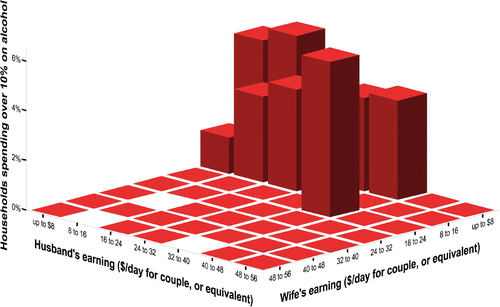
compares car ownership in the WAS survey with answers to the question ‘In the last 12 months, how often did anyone in your household cut the size of meals or skip meals because there wasn't enough money for food?’ The WAS question (used in ) was more detailed than the OHS question used for : it had four possible answers (shown in ), rather than just ‘yes’ or ‘no’. The table shows that several households went without meals ‘almost every month’, despite owning at least one car. We might think car ownership is irrelevant to nutrition, since Maslow's ‘hierarchy of needs’, a dominant model in economics, assumes consumers only buy luxuries if they can also afford necessities. casts doubt on this assumption, because some car owners were unable to afford food. Before we abandon Maslow's view, we should consider another possibility: that one or more household members can afford necessities and luxuries, while other members of the same household receive neither. Other analysis in this paper suggests that some men treat themselves to luxuries while children in their household go hungry.
Table 1: Number of cars owned by households, by frequency of cutting meals in the past year
shows women's attitudes, as revealed in their responses to the question ‘Do you agree or disagree with the statement that a wife should always obey her husband?’ Replies were coded 1 for ‘strongly agree’, or 0 for any other reply (slightly agree, neither agree or disagree, disagree, slightly disagree, strongly disagree). The figure shows that women were more likely to strongly agree if they had no earnings, while their husband was earning. ( also has other ‘spikes’ where the wife's earnings are equivalent to $32−40 for a childless couple – perhaps random ‘noise’ resulting from the relatively small WAS sample.) is consistent with the hypothesis that a woman who cannot support herself financially feels powerless, and unable to control household decisions; hence, the ‘children fare better’ hypothesis may be related to a woman's view on obedience to her partner. Qualitative research may be appropriate to investigate this issue further.
uses OHS data on injuries received by women in the 12-month period before the interview. This figure is included on the assumption that such injuries reflect a pattern of GBV, but it is impossible to test this assumption with the available data. There are two reasons to question this assumption: first, it suggests that all women's injuries reported to OHS were caused by GBV, rather than other causes such as accidents – we cannot assess this without more data. The second problem is that may understate the prevalence of GBV: many forms of male violence against women (such as a slap) cause no injury, and would not appear in ; also, some women may feel too afraid to report their injuries.
If we use as a measure of GBV, then it suggests a possible explanation of the high prevalence of hunger in and . looks fairly similar to (except that in there is little injury where neither partner earns much: there may be less reason to argue over money if there is very little to spend).
, like , allows us to investigate possible links between GBV and the ‘children fare better’ argument. It considers responses to the following question in the DHS survey (Department of Health, Citation2002): ‘Within the last year, has your partner/husband regularly not provided money you need for food, rent or bills but has money for other things?’ This could be argued as being central to the ‘children fare better’ claim, since it asks the wife whether her partner is mis-spending money. indicates that a large fraction of women (19 per cent) reported that their partner spent money inappropriately. It also indicates a link between such mis-spending and domestic violence: the fraction of women who reported mis-spending by partners was 17 per cent among women who had not been hit by their partner, compared with 37 per cent among women who had been hit by their partner. This suggests that some men use violence to force their partner to accept his mis-spending of household money. The 1998 South Africa DHS survey (unlike more recent DHS surveys in some countries) does not report threats of violence, so may underestimate the link between GBV and husband's misallocation of money: perhaps the threat of violence is sufficient for him to be able to mis-spend household money, without his needing to resort to actual violence.
Table 2: Whether or not husband withheld money, by wife experiencing violence
4. CONCLUSIONS
Empirical evidence in this paper can be divided into three categories. and are a test of the ‘children fare better’ hypothesis, and confirm (as hypothesised) that children do seem better fed if the mother earns money (rather than only the father): sufficient earnings for mothers seems an effective way to produce a good outcome for children. In the second category, and attempt to shed light on why the previous patterns were found. suggests that a husband who is the main or sole earner may prioritise alcohol spending over food spending. indicates that inadequacy of food often coincides with ownership of one or more cars in the household – another form of mis-spending. The third category assesses the possibility of a link between GBV and (unnecessary) child hunger: indicates that injuries (perhaps indicating GBV) are generally more common in households where the wife earns little or no money. Perhaps the likelihood that a man will perpetrate GBV and the likelihood that he will mis-spend household money are both related to a wife's earnings, because a woman can afford to leave a violent husband only if she can manage on her own income (Choice & Lamke cited in Johnson & Ferraro, Citation2000:956). suggests that a husband is much more likely to mis-spend household money if he uses violence, which confirms the impression from −5 that a low-earning or non-earning woman is vulnerable both to GBV and to mis-spending by her husband.
In development literature, it is common for writers to use $1 per day (or sometimes $2 per day) to measure poverty (World Bank, Citation2005). People earning over $1 per day are of less concern to policy-makers: it is assumed they can afford basics, such as food. But and suggest that we should question this assumption: many households go short of food even if the husband earns over $48 per day (for a childless couple, or equivalent, i.e. more than $48 per day for larger households). Such hunger in relatively well-off households could be because they spend on items other than food: two possible candidates are alcohol () and cars (). Future research could also consider other spending categories, such as prostitution, gambling or illegal drugs. This pattern is reminiscent of Pahl's Citation(1985) findings among female victims of GBV in the UK. It appears that if a husband is the main or only earner, he largely controls household spending – in some cases using force. More data could help, and the DHS seems the most promising source (because large samples are needed), but it is vital for this research that future DHS surveys include husband's income (as far as I am aware, no existing DHS survey asked the husband's income). We also need research on other countries, to discover whether South African culture differs from other cultures.
The ‘children fare better’ view (that a child tends to be adequately fed if his or her mother earns money in her own right) is a generalisation. We must beware of an oversimplified view, in which all women are seen as victims of men: some women are violent, and most men are not violent. As well as empowering mothers, we should encourage men to become better fathers.
Every child should receive adequate food. But many South African children in relatively affluent households go hungry. Apart from suffering directly caused by hunger, there are harmful long-term consequences of undernutrition, including poor health and reduced mental abilities. South Africa's future depends on feeding children adequately. There appears to be a major problem if a mother has low or zero earnings: this lowers household income, and may allow a husband to mis-spend household money.
Lundberg and Pollak (Citation1996:154–5) argue that:
The belief that ‘kids do better’ when their mothers control a larger fraction of family resources, which was presumably part of the rationale for changing the UK child benefit programme in the late 1970s, has now attained the status of conventional wisdom among development agencies.
Demographic and Health Survey data are made available by ‘Measure DHS’, Living Standards Measurement Study data by the World Bank, and October Household Survey data by the South African Data Archive. The author wishes to thank Margaret Murphy and André Noor (SOAS, London), and Professor Jenifer Piesse (King's College, London) for advice. Any errors are the author's own. An earlier version of this article was presented at London South Bank University, 9 May 2005; see www.lsbu.ac.uk/ahssps/courses/postgrad/devstudies.shtml.
Notes
References
- ABRAHAMS , N , JEWKES , R , LAUBSCHER , R and HOFFMAN , M . 2006 . Intimate partner violence: prevalence and risk factors for men in Cape Town, South Africa . Violence and Victims , 21 ( 2 ) : 247 – 64 .
- ALIBER , M . 2003 . Chronic poverty in South Africa: incidence, causes and policies . World Development , 31 ( 3 ) : 473 – 90 .
- BUKH , J . 1980 . “ Women in subsistence production in Ghana ” . In Women in rural development: critical issues , Edited by: International Labour Organisation . Geneva : International Labour Organisation .
- CENTERS FOR DISEASE CONTROL AND PREVENTION – NATIONAL CENTER FOR HEALTH STATISTICS . 2003 . Growth charts – weight-for-age tables , Atlanta, GA : Federal Interagency Forum on Child and Family Statistics . CDC. www.cdc.gov/nchs/data/nhanes/growthcharts/zscore/zwtageinf.txt and www.cdc.gov/nchs/data/nhanes/growthcharts/zscore/zwtage.txt Accessed 22 November 2003
- DEPARTMENT OF HEALTH . 2002 . South Africa DHS (Demographic and Health Survey), 1998 , Department of Health, Medical Research Council & Measure DHS+. www.doh.gov.za/facts/1998/sadhs98/ Accessed 3 August 2009
- DEPARTMENT OF SOCIAL SECURITY . 1993 . Households below average income: a statistical analysis 1979–1990/91 , London : Her Majesty's Stationery Office .
- ENGLE , P L . 1993 . Influence of mothers’ and fathers’ income on children's nutritional status in Guatemala . Social Science & Medicine , 37 ( 11 ) : 1303 – 12 .
- ENGLE , P L and MENON , P . 1999 . Care and nutrition: concepts and measurement . World Development , 27 ( 8 ) : 1309 – 37 .
- FOLBRE , N . 1986 . Cleaning house: new perspectives on households and economic development . Journal of Development Economics , 22 ( 1 ) : 5 – 40 .
- GWAGWA , N N . 1998 . “ Money as a source of tension ” . In Changing gender relations in Southern Africa: issues of urban life , Edited by: Larsson , A , Mapetla , M and Schlyter , A . Lesotho : National University of Lesotho .
- HADDAD , L . 1999 . Women's status: levels, determinants, consequences for malnutrition, interventions, and policy . Asian Development Review , 17 ( 1–2 ) : 96 – 131 .
- HADDAD , L and HODDINOTT , J . 1994 . Women's income and boy–girl anthropometric status in the Côte d'Ivoire . World Development , 24 ( 4 ) : 543 – 53 .
- HADDAD , L and REARDON , T . 1993 . Gender bias in the allocation of resources within households in Burkina Faso: a disaggregated outlay equivalent analysis . Journal of Development Studies , 29 ( 2 ) : 260 – 76 .
- HEISE , L , ELLSBERG , M and GOTTEMOELLER , M . 1999 . Ending violence against women . Population Reports , 27 ( 4 ) : 1 – 43 .
- HODDINOTT , J and HADDAD , L . 1995 . Does female income share influence household expenditures? Evidence from Côte d'Ivoire . Oxford Bulletin of Economics and Statistics , 57 ( 1 ) : 77 – 96 .
- JOHNSON , M P and FERRARO , K J . 2000 . Research on domestic violence in the 1990s: making distinctions . Journal of Marriage and the Family , 62 ( 4 ) : 948 – 63 .
- KENNEDY , E and PETERS , P . 1992 . Household food security and child nutrition: the interaction of income and gender of household head . World Development , 20 ( 8 ) : 1077 – 85 .
- LUNDBERG , S and POLLAK , R A . 1996 . Bargaining and distribution in marriage . Journal of Economic Perspectives , 10 ( 4 ) : 139 – 58 .
- ONYEJEKWE , C J . 2004 . The interrelationship between gender-based violence and HIV/AIDS in South Africa . Journal of International Women's Studies , 6 ( 1 ) : 34
- PAHL , J . 1985 . Private violence and public policy: the needs of battered women and the response of the public services , London : Routledge & Kegan Paul .
- SIMISTER , J . 2008 . Work, attitudes and spending in India, Brazil, South Africa, Indonesia, Nigeria, Kenya and Egypt, 1992–2007 , UK Data Archive, SN:3290. www.data-archive.ac.uk/findingdata/snDescription.asp?sn=3290 Accessed 15 April 2008.
- SOUTH AFRICAN DATA ARCHIVE . 2003 . October Household Surveys for 1996, 1998, and 1999 , www.nrf.ac.za/sada Accessed 20 July 2003
- UNITED NATIONS STATISTICS DIVISION . 2007 . Purchasing power parities (PPPs), national currency per international dollar, 1993 , http://data.un.org/Data.aspx?q=purchasing+power+parity&d=CDB&f=srID%3a29947 Accessed 31 July 2009
- WORLD BANK . 2005 . An introduction to PovcalNet , www.iresearch.worldbank.org/PovcalNet/Introduction.html Accessed 20 July 2005
- WORLD BANK . 2008 . South Africa 1993: Integrated household survey , Living Standards Measurement Study. http://go.worldbank.org/51LE6NV3Y0 Accessed 31 July 2009
